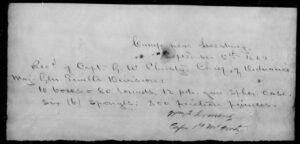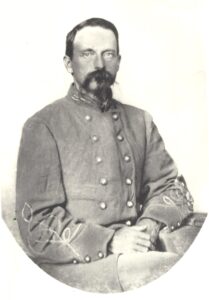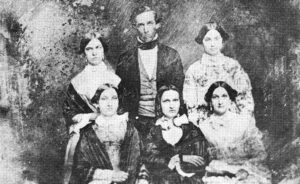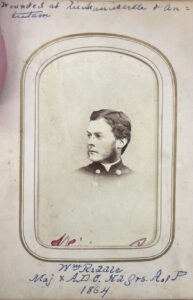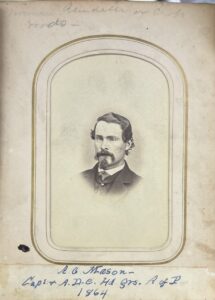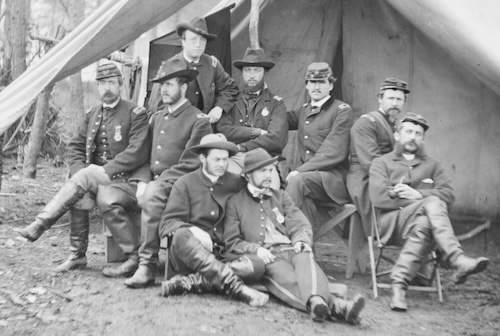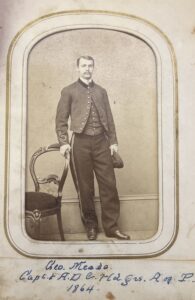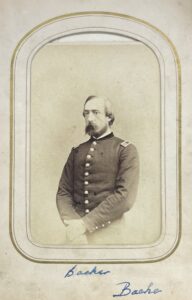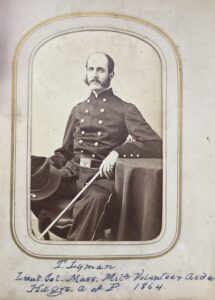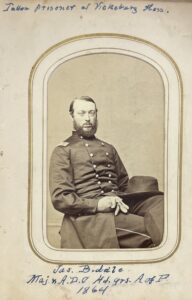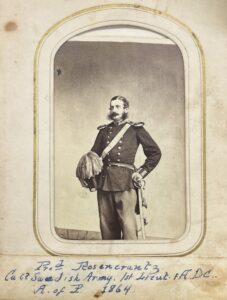Looking into Captain William F Dement, commander of the First Maryland Artillery on the campaign of September 1862, I came upon this scrap of paper – a receipt for ammunition issued to his battery at Leesburg, VA on 5 September 1862. He and his battery crossed the Potomac River into Maryland at White’s Ford that same day.
10 boxes = 80 rounds, 12 pdr. gun spher. [spherical] case.
Six (6) sponges; 300 friction primers
Food for his 4 Napoleons.
Dement joined the battery as First Lieutenant at it’s organization at Richmond, VA in July 1861, then a wealthy 35 year old planter from Charles County. Here he is at that rank:
He was promoted to Captain in July 1862, and led the battery to Appomattox in April 1865.
Notes
The receipt at the top is from Captain Dement’s Compiled Service Record jacket at the National Archives and online from fold3, a subscription service.
His photograph was contributed to his Findagrave memorial by Barbara Winston Spears.
Franklin Gaillard and family (before 1856)
23 March 2025
Franklin Gaillard, standing between his wife Catherine Cordes “Tattie” Porcher (1832-1856; m. 1853) and niece Catherine Marianne Gaillard (1835-1869). Front row: Franklin’s sisters, Lydia Henrietta (1831-1913), Elizabeth Octavia “Betsy” (1825-1908) and Marianne Gendron “Nan” (1833-1912).
A newspaper editor in Columbia, SC before the war, Gaillard was Major of the 2nd South Carolina Infantry on the Maryland Campaign of 1862 and took command of the regiment at Sharpsburg after Colonel Kennedy was wounded in action near the Dunker Church on the morning of 17 September.
He saw further combat at Fredericksburg, where he was wounded, Chancellorsville, and Gettysburg – by then Lieutenant Colonel and in command – through Chickamauga and Knoxville into the Fall of 1863. He was killed in battle in the Wilderness of Virginia on 6 May 1864. He was 35 years old.
Note
The photograph above is from descendent and author Frye Gaillard published in Alabama Living Magazine, 2 July 2015. I’ve not yet found a wartime picture of Franklin Gaillard.
Riddle and Mason, aides-de-camp (1864)
8 March 2025
William Riddle, from a prosperous and well-known Pittsburgh family, was 19 years old when he enrolled as 2nd Lieutenant of Company F of the 5th Pennsylvania Reserves in October 1861. His First Lieutenant, from Towanda in Bradford County, was Addison G Mason – also from a wealthy family. He’d enlisted at age 19 in June 1861. Here they are in formal portraits taken in 1864:
Both were detailed as aides to Brigadier General George G Meade before the Battle of Antietam in September 1862 and were in action with him there.
Both young officers were commissioned in the staff corps of the US Volunteers in the Spring of 1863, Riddle as a Major and Mason a Captain. Riddle was sent to Major General John Reynolds’ staff, and was with that officer when he was killed at Gettysburg on 1 July 1863; he then returned to Meade’s staff.
Here they are again, among others of Meade’s personal staff in a photograph taken by Timothy O’Sullivan at Brandy Station, VA in April 1864:
Riddle is sitting cross-legged on the ground (left) – that’s the General’s son George, Jr. sitting more or less in his lap. Mason is seated on a bench in the back row at far right.
Both men survived the war – Riddle resigned for health reasons in December 1864 and Mason mustered out in May 1865.
They have something else in common: neither man died of simple old age.
William Riddle was killed just two years after the war in a bar fight in Philadelphia on his 25th birthday. Addison Mason lived much longer, to age 54, and was killed when the bottom fell out of the car and he “precipitated” to the bottom of a coal mine shaft.
Notes
Description of that Brandy Station picture from the Library of Congress:
Photograph printed by Alexander Gardner from negative by Timothy O’Sullivan shows group portrait of identified soldiers posed in front of tent: Captain Francis Markoe Bache of 16th U.S. Infantry, Lieutenant Colonel Theodore Lyman III, aide-de-camp, Captain C.E. Cadwalader of 6th Pennsylvania Cavalry, Major William Riddle of 34th Pennsylvania Infantry; Major James Biddle of 16th U.S. Infantry, Captain George Meade Jr. of 6th Pennsylvania Infantry, Captain John Coalter Bates of 11th U.S. Infantry, Captain Addison Gordon Mason of 34th Pennsylvania Infantry, and Lieutenant Frederik Anton Ulrik Rosencrantz of 16th U.S. Infantry.
The two photographs at the top were part of the collection of William Fadjo Cravens Jr. (1929-2012), and were offered for sale by his estate. Alert member kwinlr saved them to the FamilySearch database, along with these of others of Meade’s staff (George G Meade, Jr., Bache, Lyman, Biddle, & Rosenkrantz):
George Meade, Jr., by the way, was a cadet at West Point from June 1860 to June 1862, when he left with “an excess of demerits.” He enlisted in the 8th Regiment, 1862 Pennsylvania Emergency Militia as a Private in Company G on 11 September 1862 – at the height of the alarm about Lee’s invasion of the North – and mustered out with them two weeks later. He enlisted as a Private in Company C of the 6th Pennsylvania Cavalry in November, and was probably commissioned 2nd Lieutenant by May 1863, when he was appointed Captain & ADC to his father. A role he played to the General’s death in 1872.
